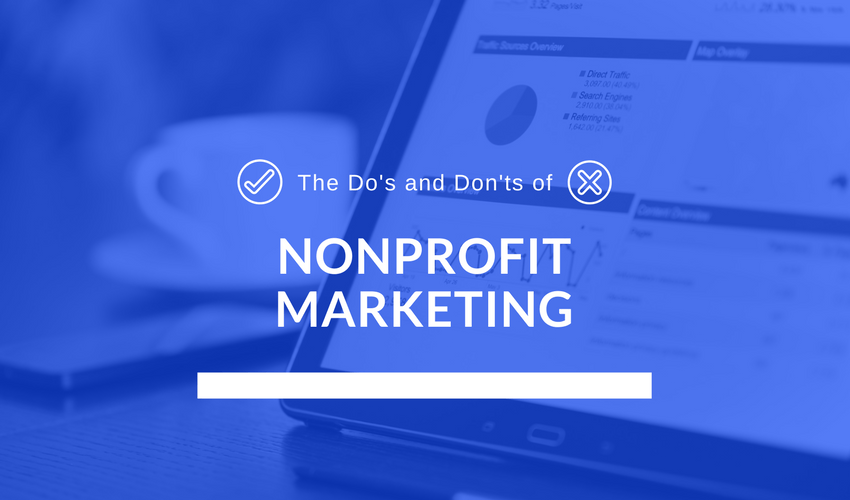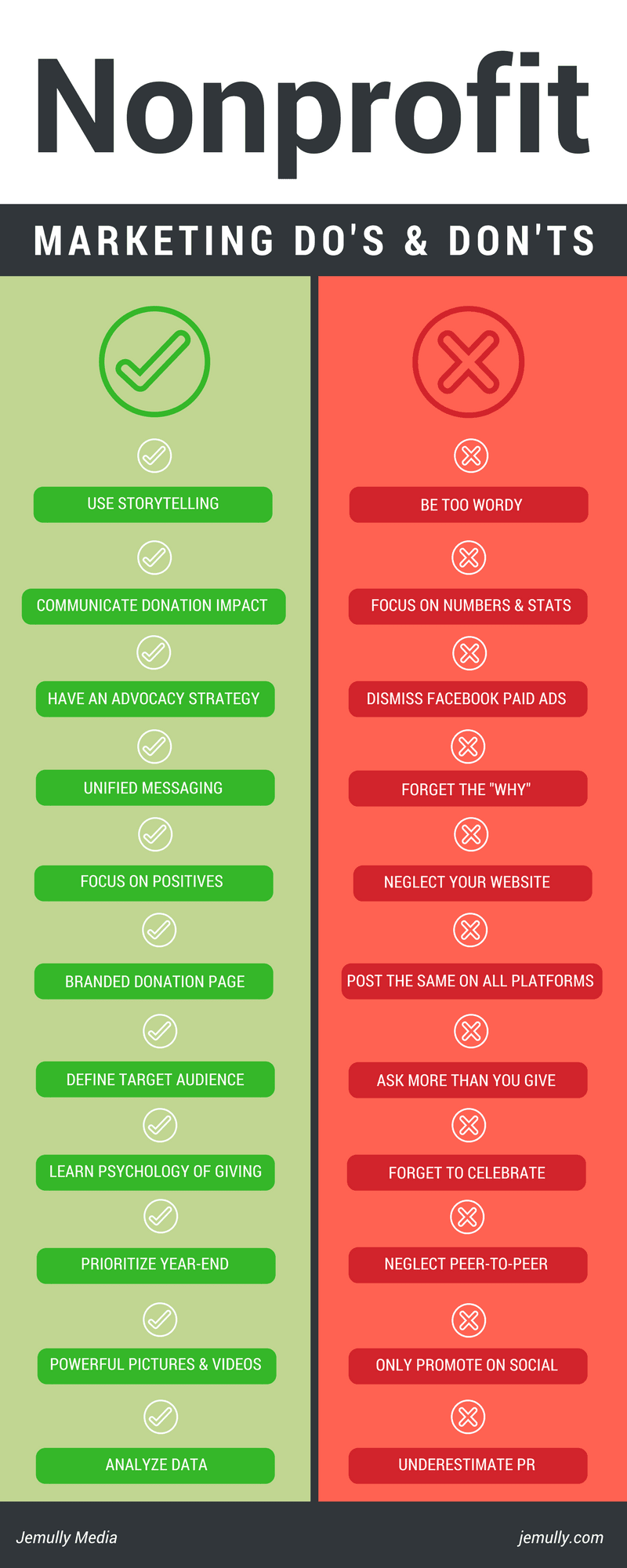Though tricky to accomplish, proper marketing is just as vital for nonprofits as it is for any other company. Unlike businesses with the advantage of marketing a tangible product or service that will benefit their audience, nonprofits face the challenge of having to communicate their particular cause in hope of attracting donors, volunteers, or advocates.
Sadly, many nonprofits neglect to invest in their marketing efforts due to tight budgets. In her blog post, Alyssa Conrardy, President and Co-Founder of Prosper Strategies, explains,
Marketing and communications are some of the first line items nonprofits choose to cut when uncertainty hangs over their heads or when finances get tight. But that’s a huge mistake. Marketing, communications and fundraising play a critical role in organizational growth, sustainability, and mission achievement, and cutting their budgets at the wrong time can make a tough financial situation even more precarious.
Yes, investing in marketing requires time and money, but it is critical to your organization’s success. The goal of any nonprofit organization’s marketing efforts is to raise awareness and inspire action, but achieving that is not always easy.
We have compiled a list of nonprofit marketing do’s and don’t’s in hopes of making it a little easier.
Do:
1. Use storytelling as main communication tool
Nonprofits MUST embrace and utilize the power of storytelling. Stories will have the greatest impact on your audience, and create a relatable point-of-entry. While you may be tempted to just spew the facts about all the good your organization is doing, it is much more powerful to share stories that will demonstrate the good you are doing. Show, don’t just tell.
2. Clearly communicate the impact of a donation
Donors want to feel like they’re making a difference and they want to know the direct impact they will have when they give to your organization. This is especially true for first-time donors. If you want to turn first-time donors into recurring donors, your organization must find a way to communicate to every single donor exactly how their contribution was or will be used and the impact it made.
3. Develop an advocacy strategy
Donating money and volunteering is not the only way for your donors to contribute to the success of your organization. Consider creating an advocacy strategy in order to facilitate growth by spreading your organization’s mission to more people. Create a clear strategy that will make it easy for your supporters to advocate on your behalf. According to an article by Upleaf,
Launching a successful advocacy campaign can boost your credibility, give people an easy opportunity to take action, and expand your community of supporters. That’s all gravy on top of the fact that it may also make a meaningful impact in the real world.
4. Present a unified message across all platforms
Most organizations have many platforms and outlets that they communicate through: email, newsletter, website, donation landing pages, social media, etc. It is important to distribute your campaign message through all or most of your touch points. This will get your message in front of as many people as possible, as many times as possible. Keep the message consistent to prevent any confusion that may discourage a prospetive donor.
5. Focus on the positives
I know I’m not the only one who feels creeping emotional manipulation every time the ASPCA ad comes on and Sarah McLachlan’s “Angel,” starts playing. Your organization should evoke a feeling of happiness and positivity in your messaging that will inspire donors to give, rather than guilting them into giving through negative or sad messaging. Although there is a time for using sad, emotional appeals, it should be used sparingly. An article on Medium titled, “Should charities use positive or negative empathy appeal in marketing?”, states,
Study shows that sharing a positive impact message with donors helps create long lasting donor relations. ‘The public are tired of the continuous images of distress being dumped upon them,’ says Leigh Daynes, Executive director of Doctors of the world. ‘Charities need to stop presenting beneficiaries as hapless victims and make sure that people are engaged over the longer term.’
6. Create branded donation and fundraising pages
As mentioned previously, your campaign branding and messaging should be consistent across all platforms, including your donation landing pages. It is important that donors can connect the dots when moving from one step to the next. The design and message on your donation and fundraising pages should match that of your campaign. According to Network for Good’s Digital Giving Index,
…donors give higher average gift amounts when the giving experience happens on a branded donation page that matches a nonprofit’s design and message.
7. Define and understand your audience
Every organization must define and understand who their target audience is. This requires developing audience personas to learn how to best communicate with them. Once you know and understand who you’re targeting, you can build your marketing strategy around reaching that specific audience.
8. Understand the psychology of donor giving
It is important to learn what motivates people to give through the psychology of donor giving. This will help you understand how your organization can shape your fundraising objectives to meet the needs of potential donors in order to increase contributions.
9. Prioritize your year-end campaign
Did you know that over 30% of annual giving happens in the month of December? People tend to get more involved with nonprofits and charitable organizations over the holidays. It’s undeniable that the average person’s generosity and kindness is magnified during the holiday season. Additionally, the end of the year is a time many donors use to lighten their taxable income burden, while making a meaningful gift at the same time. Therefore, your organization should make the most out of year-end by making it your biggest and best campaign of the year.
10. Use powerful visuals and videos
A picture truly is worth a thousand words when it comes to nonprofit marketing. Including pictures and videos on social media posts not only increases engagement but it also helps communicate your story better. Video content is one of the most impactful and compelling ways your organization can share the story.
11. Measure and analyze data
Without measuring and analyzing your current marketing, you can’t optimize your strategy for better results. Always make time to evaluate your data so you can continually improve upon your tactics and set new goals.
Don’t:
1. Be too wordy
I said it once and I’ll say it again: a picture really, truly is worth a thousand words. You must also keep in mind that you know a lot more about your organization than your audience does. It can be easy to get overly wordy and technical when writing about your organization. There’s no need to dumb things down, but you don’t want the content to go in one ear and out the other. You can achieve this by keeping your content simple and interesting, and above all, aiming for clarity.
2. Focus on communicating numbers or statistics
Although it is important to communicate to your donors the impact of their donations, you want to do so in a compelling way. Heartfelt stories from those who have been affected or impacted by your organization are much more powerful than numbers and statistics.
3. Dismiss Facebook paid advertising
Organizations often fail to invest in Facebook ads. Do not underestimate the role Facebook can play in helping you to strategically execute your paid campaign. When it comes to big campaigns such as Giving Tuesday and Year-End, do not dismiss this tool. It will get your campaign and cause in front of more eyes and attract potential donors.
4. Forget the “why”
A Network For Good article advises,
…when asking someone to do something—whether that’s making a donation, volunteering, or putting trash in its proper place—don’t forget to tie your ask to why it matters. Why should they care? Why will it make a difference?
These are two important questions to ask yourself before making any fundraising ask. In your messaging strategy, always remember to convince your audience of why they should care.
5. Neglect your website
Think of your website as your organization’s online hub. Even through social media, your goal should always be to direct your audience back to your website. Many organizations prioritize social media use or other online marketing efforts, but neglect their website. This is a huge mistake, especially for nonprofits.
Social media is important, but a strong website presence give you the most control over your message. In an article by Caryn Stein, a nationally-recognized speaker and trainer for nonprofits, she explains,
Whether they give online or off, supporters will look at your website to understand more about your work, how their gift will make a difference, and they will form opinions about what they find there. So, it’s in your best interest—and of those you serve—to make the most of your website and ensure that it’s creating the right environment to inspire giving.
6. Post the same way for all social platforms
Although you should have a unified approach and message strategy, your posts should not be the exact same among all your social platforms. Each platform has different audience demographics and best practices. For example, Instagram is a very visual-centric platform, whereas Twitter is more about words. Another example of this is that Twitter is an acceptable platform for publishing content multiple times a day, however this would not be wise to do on Instagram. Differentiating your posts for each platform is also important because if your audience follows you on multiple different platforms, they do not want to see the exact same post, say, on Facebook that they might have just seen on Instagram. Make sure your organization is taking the time to tailor its content for each platform.
7. Ask more than you give
When it comes to marketing, many nonprofits make the mistake of asking too often and rarely giving value to their audience. According to an article from Cosmic, a creative marketing agency specializing in social purpose brands,
…a healthy rule of thumb is 3:1 giving to asking. For every communication that is an ask, there should be at least 3 that are sharing stories of success, providing proof of impact (which doesn’t have to be focused on numbers), or sharing a point of view or belief that is compelling or thought-provoking.
8. Forget to celebrate success
When your organization hits a milestone or achieves a goal, remember to celebrate the people that helped make it happen! Not only is it important to share results with donors, but it is especially important for those who have not yet donated to see that your organization is, in fact, making a difference and is successful in its efforts. When you celebrate what your organization is accomplishing, it could result in new donors.
9. Skimp on peer-to-peer fundraising strategy
Peer-to-peer fundraising is important for reaching a larger network of people and attracting new donors. When your donors are advocating on your behalf while sharing your message, it results in one of the most organic and effective forms of marketing: word of mouth. Additionally, supporters who are involved in peer-to-peer fundraising deepen their involvement in your organization and its mission.
10. Use social media to only promote your organization
No one wants to follow self-absorbed organizations who only talk about and promote themselves. This is where the rule of thirds comes in:
- One-third of your social content should promote your organization to convert followers and generate donations
- One-third of your social content should share insights and stories from thought leaders in your industry or similar organizations
- One-third of your social content can be fluff, such as fun and organic content that shows the human side behind your social media marketing
11. Underestimate the power of PR
PR is especially important for nonprofits. According to an article from Nonprofit Hub, here’s why your organization should not shy away from PR efforts:
Powerful PR is a vital component to any successful fundraising campaign. It generates brand awareness, builds buzz, and increases credibility. If a donor or potential corporate sponsor is reading about you in the press, hearing your story on the radio, and seeing your name appear in blogs—they’re going to take notice. And if your story resonates with them, they’re going to get involved. Unfortunately, many nonprofit leaders are quick to dismiss PR. They think it’s too expensive and difficult to measure. I’m here to tell you that you can’t afford not to do PR.
Although nonprofit marketing can be difficult, it will pay off in the long-run. The process of implementing marketing strategies for your organization can be daunting, but we hope these tips have provided clarity and will help in bringing success.
If you have any tips that we’ve missed, then we’d love to hear them!






